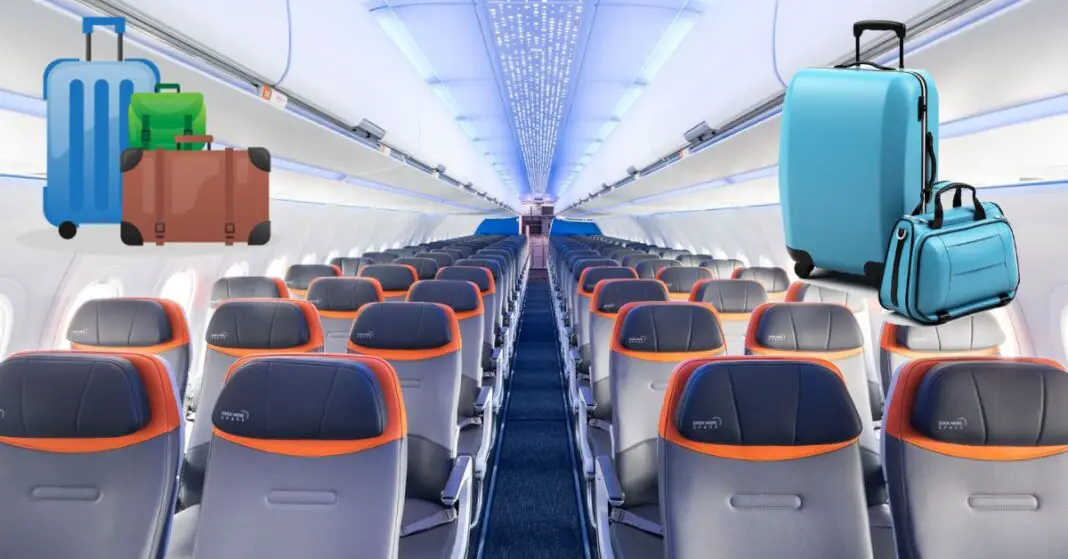As the excitement of an upcoming flight encapsulates, one essential element that shouldn’t be compromised is the preparation and conforming to the airline’s baggage policy. This is especially true if you are planning to fly with JetBlue, which has specific rules about the size and weight of both your carry-on and checked luggage.
This article features a detailed discussion about JetBlue’s baggage policy, including methods to accurately measure your luggage to guarantee it fits their carry-on allowance. Additionally, we’ve curated some useful packing tricks to optimize your limited space, making sure you can pack everything you need, sans trouble.
Table of Contents
Understanding JetBlue’s Baggage Policy
JetBlue Airways, a spearhead in the aviation industry, has always stayed at the vanguard of customer service. One key area that garners significant attention is their well-developed baggage policy. Stitched together with a deep understanding of customer needs, this policy ensures travel comfort while maintaining uncompromised safety standards. This article aims to provide a concise guide to JetBlue’s baggage policy as it pertains to carry-on luggage.
JetBlue’s baggage policy underscores its commitment to a stress-free travel experience. Each passenger is allowed one carry-on bag and a personal item such as a briefcase, purse, or laptop bag. Importantly, JetBlue does not impose any fees for these carry-on items, thus providing a competitive edge over other airlines where these charges can be a point of contention.
Understanding the size and weight restrictions is critical to avoiding any travel hiccups. JetBlue’s maximum size for a carry-on bag is 22″ L (55.88 cm) x 14″ W (35.56 cm) x 9″ H (22.86 cm), including handles and wheels. This is a common space allocation in aircraft overhead bins. Meanwhile, a personal item should not exceed 17″ L (43.2 cm) x 13″ W (33 cm) x 8″ H (20.32 cm) so it can comfortably fit under the seat in front. There is no weight limit specified for carry-on items, but it’s advisable to keep it manageable for easy handling.
Following these guidelines helps minimize friction during the boarding process. Furthermore, efficient packing within these confines enables a smoother security check, a considerable benefit, given the constantly evolving landscape of airport security.
Those with a Child Restraint System (CRS) or an FAA-approved car seat for minors would be pleased to learn that these items are in addition to the one-bag plus one personal item allowance. This thoughtful provision enhances family travel convenience.
JetBlue’s baggage policy represents a paradigm of consumer-friendliness while taking due cognizance of the economic realities of air travel. The policy, designed with a fine balance of customer considerations and operational efficiency, enables optimum utilization of cabin space without compromising the comfort and convenience of the passenger.
In conclusion, appropriate comprehension and adherence to JetBlue’s baggage policy do far more than ensuring compliance. It contributes to creating a relaxed and enjoyable flying experience, a mission aligned with JetBlue’s broader commitment to revolutionizing air travel.
Measuring Your Luggage Correctly
Concerning JetBlue’s hallmark commitment to excellence, carry-on baggage measurements play a crucial role in ensuring a flawless and enjoyable flying experience for all passengers. It’s not merely about avoiding fees – it’s about optimizing packing efficiency and expediting the security screening process.
As many savvy travelers understand, JetBlue generously allows one carry-on bag and one personal item, such as a purse or briefcase, onboard. But to comply with their policies and ensure a swift boarding process, understanding how to accurately measure luggage to meet JetBlue’s standards becomes indispensable.
To start with, dimensions matter. The maximum size for a carry-on bag on JetBlue is 22” length × 14” width × 9” height, inclusive of wheels and handles. Personal items should not exceed 17” length × 13” width × 8” height. Measuring luggage isn’t complicated, but precision is key.
Here’s a systematic approach for this task:
- Place the suitcase upright on a flat surface.
- Measure the height of the bag from the floor to the topmost part of the suitcase, including wheels or handles.
- Next, check the width of the suitcase from one side to the other using the same measuring unit.
- Finally, measure the depth from the back to the front of the suitcase.
Remember, all measurements must be consistent. Using inches as the unit of measurement will save time since JetBlue’s requirements are expressed in inches.
On a similar note, those traveling with an infant can carry a full-size Child Restraint System or FAA-approved car seat which is exempt from these size limitations. This sensible policy illustrates JetBlue’s unique blend of customer-centric thinking and smart operational efficiency.
There’s a lot that hinges on the simple task of measuring carry-on luggage. An accurate measurement ensures that the passenger complies with JetBlue’s policies, facilitates a prompt security check, and contributes to an overall relaxed travel experience.
So the next time you fly with JetBlue, remember to measure your carry-on luggage methodically. It’s not just about packing smart – it’s about traveling with absolute peace of mind, enabling you to focus on work, enjoy leisure, and make the most out of your flying experience.
Innovation, after all, does not stop at the creation of products and services but extends into every aspect of professional life, including the art of traveling light and right.
Packing Tips to Maximize Space
In an era characterized by swift movement and perpetual innovation, packing smartly and efficiently has never been more paramount. Beyond the convenience for the traveler, it becomes a strategic approach for airlines to maximize customer satisfaction and operational efficiency. In light of this, there are several packing tips to ensure your belongings fit within the allowed carry-on size which reflects strategic thinking, innovation, and efficiency.
One must remember that precision is the key to excellence. Begin by creating a packing list to curate the essentials for your trip. This list essentially becomes your blueprint and would streamline your packing process remarkably. Prioritize items based on their relevance and necessity, this imminent pre-organization will give you a clear vision of what is essential and what can be discarded, freeing up valuable bag space.
Smart packing goes beyond just fitting in items. Consider the nature of the items you’re packing; utilize lighter items to provide padding for heavier or more delicate objects. This not only conserves space but also protects your valuables.
A handy pointer to truly maximize space is by rolling your clothes instead of folding them. This popular method among seasoned travelers – and a great demonstration of innovative problem-solving – is known to free up crucial space and reduce wrinkles.
Also, seek out multi-use items: think a jacket that turns into a travel pillow, a scarf that can double as a wrap, or clothing with built-in UV protection. With these items, you can enjoy a higher utility value for potentially less space.
To further optimize space, it’s advisable to leverage travel-size toiletries. These compact versions of your day-to-day utilities significantly reduce the bulk in your bag. Simultaneously, they are a fantastic tool to navigate through security checks smoothly, given they adhere to most airlines’ liquid restrictions.
Remember, staying aware of the latest trends that marry innovation and convenience is essential. Modern travel-specific gadgets and accessories, such as compression bags and multi-pocket travel jackets, can dramatically decrease the space taken up in your carry-on.
Finally, consider the nature of your itinerary. If you’re bound for a business conference, there’s a world of space-saving business travel gear at your disposal – everything from wrinkle-resistant business wear to compact, portable devices. True business savvy is about adapting to requirements on the go – and your packing strategy should be no different.
Undeniably, the process of packing efficiently resonates with the principles of effective business conduct – strategizing, discarding inefficiency, incorporating innovation, and being adaptable. Making these principles work for you on the go can be just as rewarding as they are in business, assisting you to stay one step ahead and travel with the ease and assurance you desire. Remember, every detail matters when working towards excellence – and this includes ensuring your carry-on bag fits just right.
Being well-informed about the specifics of JetBlue’s luggage policy and learning how to properly measure your bags can eliminate unwanted hassles at check-in.
Following simplifying packing strategies will not only guarantee that you accommodate everything you need in your trip, but it also assures that you are following JetBlue’s carry-on requirements. With this gained understanding, smooth and worry-free travel with JetBlue is within your reach. You are now ready to rock your trip and take on new adventures with JetBlue.
Is JetBlue strict with carry-on size?
JetBlue maintains a strict stance on carry-on size, particularly during busy travel periods or on fully-booked flights. They adhere to the standard dimensions of 22 inches x 14 inches x 9 inches, encompassing wheels and handles. Any deviation beyond these limits, even if slight, may result in gate-checking or incurring a fee.
Can I bring a backpack and a carry-on JetBlue?
When flying with Blue Basic, your carry-on flies solo – no backpack or carry-on buddies allowed. If you bring both, be prepared to pay, starting at $65 each. On the bright side, with Blue, Blue Plus, Extra, and Mint fares, it’s a party for two! You can bring one carry-on and your trusty backpack along for the ride without additional charges.
Keep in mind that the overhead bin prefers them compact, with dimensions limited to 22x14x9 inches, so pack smart. Before you take off, check JetBlue’s baggage information for details, and have a fantastic journey!
Does JetBlue charge for carry-on?
JetBlue’s carry-on policy varies with your ticket type. With Blue Basic, your carry-on travels solo as no overhead bin companion is permitted. Bringing one incurs a fee starting at $65. However, for Blue, Blue Plus, Blue Extra, and Mint fares, it’s a party of two! You can bring one carry-on and one personal item (such as a purse or laptop bag) for free. Make sure they adhere to the size limit of 22x14x9 inches and pack wisely. For complete details and peace of mind, review JetBlue’s baggage information before taking off!
What size toiletries can you take on JetBlue?
When considering toiletries for your JetBlue carry-on, opt for mini marvels! Ensure each container holds 3.4 ounces (100 milliliters) or less and can comfortably fit into a single quart-sized, clear, zip-top plastic bag. This bag should undergo security screening separately, so keep it easily accessible.
What is not allowed in a carry-on bag JetBlue?
Leave behind any thoughts of packing your arsenal when flying with JetBlue! Weapons, flammables, chemicals, and even the latest hoverboards are strictly prohibited in your carry-on. Ensure that liquids are downsized and well-organized in travel-sized containers. Keep in mind that TSA agents have the ultimate say, so if anything seems questionable, stow it securely in your checked luggage. Wishing you safe and rule-abiding travels!
Can I bring a razor in my carry-on JetBlue?
You are allowed to carry most disposable and cartridge razors in your JetBlue carry-on bag, as long as the blades are safely enclosed. Make sure to pack them securely, preferably in a hard-sided case. However, safety razors and blades are not permitted in carry-on luggage.





